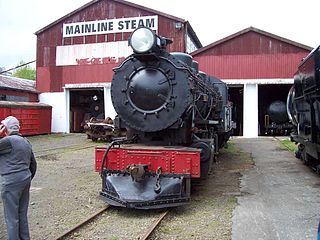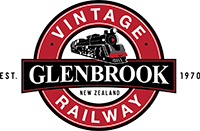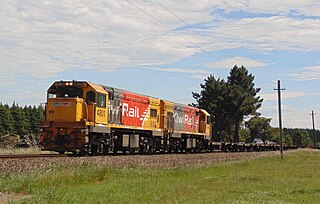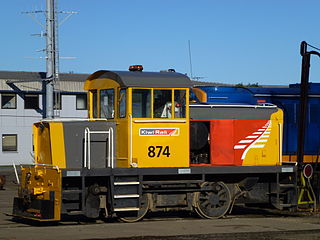
Railway preservation in New Zealand is the preservation of historically significant facets of New Zealand's rail transport history. The earliest recorded preservation attempt took place in 1925, although the movement itself did not start properly until 1960.

The NZR K class of 1877 was the first example of American-built locomotives to be used on New Zealand's rail network. Their success coloured locomotive development in New Zealand until the end of steam.

The New Zealand F class was the first important class of steam locomotive built to operate on New Zealand's railway network after the national gauge of 3 ft 6 in was adopted. The first locomotives built for the new gauge railways were two E class double Fairlies for the Dunedin and Port Chalmers Railway Company. The F class was the first class ordered by the central government, and between 1872 and 1888, a total of eighty-eight members of the class were constructed.

The Ocean Beach Railway (OBR) is a heritage railway that operates in Dunedin, New Zealand. It is located between John Wilson Drive in the suburb of Saint Kilda and sports grounds near Forbury Park Raceway, and runs parallel with the city's main beach, Ocean Beach. This is near where the Ocean Beach Branch once ran, but not on the same formation.

The NZR AB class was a class of 4-6-2 Pacific tender steam locomotive that operated on New Zealand's national railway system for New Zealand Railways (NZR). Originally an improvement on the 1906 A class, 141 were built between 1915 and 1927 by NZR's Addington Workshops, A & G Price of Thames, New Zealand, and North British Locomotive Company, making the AB class the largest class of steam locomotives ever to run in New Zealand. An additional eleven were rebuilt from the tank version of the AB – the WAB class – between 1947 and 1957. Two North British-made locomotives were lost in the wreck of the SS Wiltshire in May 1922.
Locomotives of New Zealand is a complete list of all locomotive classes that operate or have operated in New Zealand's railway network. It does not include locomotives used on bush tramways.

The P class was a class of steam locomotives built to haul freight trains on the national rail network of New Zealand. The class consisted of ten individual locomotives ordered from the British company of Nasmyth, Wilson and Company in 1885, but miscommunications about the weight limitations imposed on the locomotives meant they did not start work until 1887. This debacle came at a time when the New Zealand Railways Department (NZR) was suffering from a lack of motive power to work on its rapidly expanding network and was part of what prompted a shift towards American and home-grown manufacturers.

The BA class was a class of steam locomotive built by the New Zealand Railways Department (NZR) for use on New Zealand's national rail network. The first BA entered service in November 1911, with the last of the 11 class members introduced on 14 May 1913.

The Glenbrook Vintage Railway (GVR) is a heritage steam railway in Glenbrook, New Zealand.

The NZR JA class was a class of fifty-one 4-8-2 steam locomotives operated by the New Zealand Railways Department (NZR). The locomotives were built in two batches; the first batch was constructed in-home at the Hillside Workshops at Dunedin between 1946 and 1956, while the second batch was produced by the North British Locomotive Company (NBL) of Glasgow, Scotland in 1951. To differentiate between the two batches, the locomotives were identified by their builder.

The New Zealand DC class locomotive is a type of diesel-electric mainline locomotive on the New Zealand rail network, operated by KiwiRail on freight trains, and formerly on long-distance passenger trains. The class was rebuilt from the DA class in the late 1970s and early 1980s, mainly in Australia. After the DA class, they were the most numerous class of diesel locomotive on New Zealand's railway network and remained numerically dominant until the mid-2010s when withdrawals began.

The NZR J class was a class of forty 4-8-2 steam locomotives operated by the New Zealand Railways Department (NZR). Although designed to work on the lighter secondary lines, the class was frequently used on mainline express passenger trains as well as freight. When first introduced, the class boasted distinctive streamlining, which was later removed from 1947 onwards for maintenance reasons. Three of this class remained in service until the end of steam operation on 26 October 1971, when they were withdrawn and entered into preservation. This class should not be confused with the earlier J class from 1874.

The New Zealand DB class and DBR class locomotive is a type of diesel-electric locomotive built for service on New Zealand's rail network. They were built by General Motors Diesel (GMD) of Canada as a narrow-gauge version of the EMD G8 model, with seventeen locomotives constructed. Ten of these were later rebuilt into the DBR class.

The New Zealand DSC class locomotive is a heavy shunting locomotive used throughout New Zealand. The class was built in seven batches, the first 18 locomotives being built by British Thomson-Houston of the United Kingdom, with the remainder being built by New Zealand Railways (NZR).

The NZR W class consisted of two steam locomotives built at the Addington Railway Workshops in Christchurch, New Zealand by the New Zealand Railways Department (NZR). They were the first locomotives to be built by NZR.

The New Zealand TR class locomotive is a type of diesel shunting locomotives built by many different manufacturers. Defined as "shunting tractors" or "rail tractors" by KiwiRail and its predecessors, they are classified "TR" for tractor as a result. Many of these locomotives have been withdrawn, but some are still in service. The first locomotive of this class was built by NZR in 1924. The most powerful were Japanese-built Hitachi TRs, with 138 kW Cummins engines.

Steam Incorporated, often abbreviated to Steam Inc., is a railway heritage and preservation society based at the Paekākāriki railway station, Paekākāriki at the southern end of the Kāpiti Coast, approximately 50 minutes north of Wellington on the west coast of New Zealand's North Island. Unlike some societies who operate on preserved sections of closed branch lines, Steam Incorporated owns a depot beside one of the country's most important railway lines, the North Island Main Trunk railway, and restores heritage locomotives and rolling stock for use on excursions on the regular national rail network.

The New Zealand V class steam locomotive was used on New Zealand's railway network from 1885 onwards. They were operated by New Zealand Government Railways and the Wellington and Manawatu Railway Company.

Branxholme locomotive dump is a steam locomotive and wagon dump located on the eastern bank of the Ōreti River adjacent and just to the north of Southland's Wairio Branch Line in New Zealand. Locomotives and rolling stock have been dumped here for river protection since the 1920s. In the time since numerous items have been recovered for preservation purposes.

The Oamaru Steam and Rail Restoration Society was formed in 1985 to preserve PWD 535. Since establishment the Society has acquired and preserved Hudswell Clarke built 0-4-0ST B10 of 1924 from the Pukeuri Alliance Freezing Works, a Robert Stephenson & Hawthorns shunter No.7908 of 1962 from the Pukeuri Alliance Freezing Works and TR 35 of 1939 from the New Zealand Railways Corporation. The society also currently has DSA 234 on loan to them by one of their members. The railway is located in Oamaru's Historic Precinct, utilising a portion of the former New Zealand Railways Oamaru yard. Train travels every Sunday from Harbourside Station to Quarry Siding located by the Oamaru Blue Penguin Colony, alongside Oamaru's Victorian Harbour.


























